Stereotyping: An Obstacle - Psychology Research Paper, Semester 1
VerifiedAdded on 2022/08/21
|9
|2474
|12
Essay
AI Summary
This research paper, titled "Stereotyping: An Obstacle," explores the multifaceted nature of stereotyping and its pervasive influence across various aspects of society. The paper begins by defining stereotyping and its connection to social categorization and prejudice, referencing key studies and definitions. It then delves into the diverse types of stereotyping, including racial, gender, and political stereotyping, and examines their historical and cultural contexts. The discussion progresses to explore the sources of stereotyping, including human cognitive tendencies, environmental factors, and illusory correlations. The paper further analyzes the detrimental effects of stereotyping on individuals, organizations, and educational systems, highlighting its impact on areas such as ageism, workplace discrimination, and academic performance. The conclusion emphasizes the negative consequences of stereotyping and advocates for equality as a means to combat its harmful effects. The paper utilizes a range of scholarly sources to support its arguments, providing a comprehensive analysis of stereotyping's impact on human development and societal well-being.
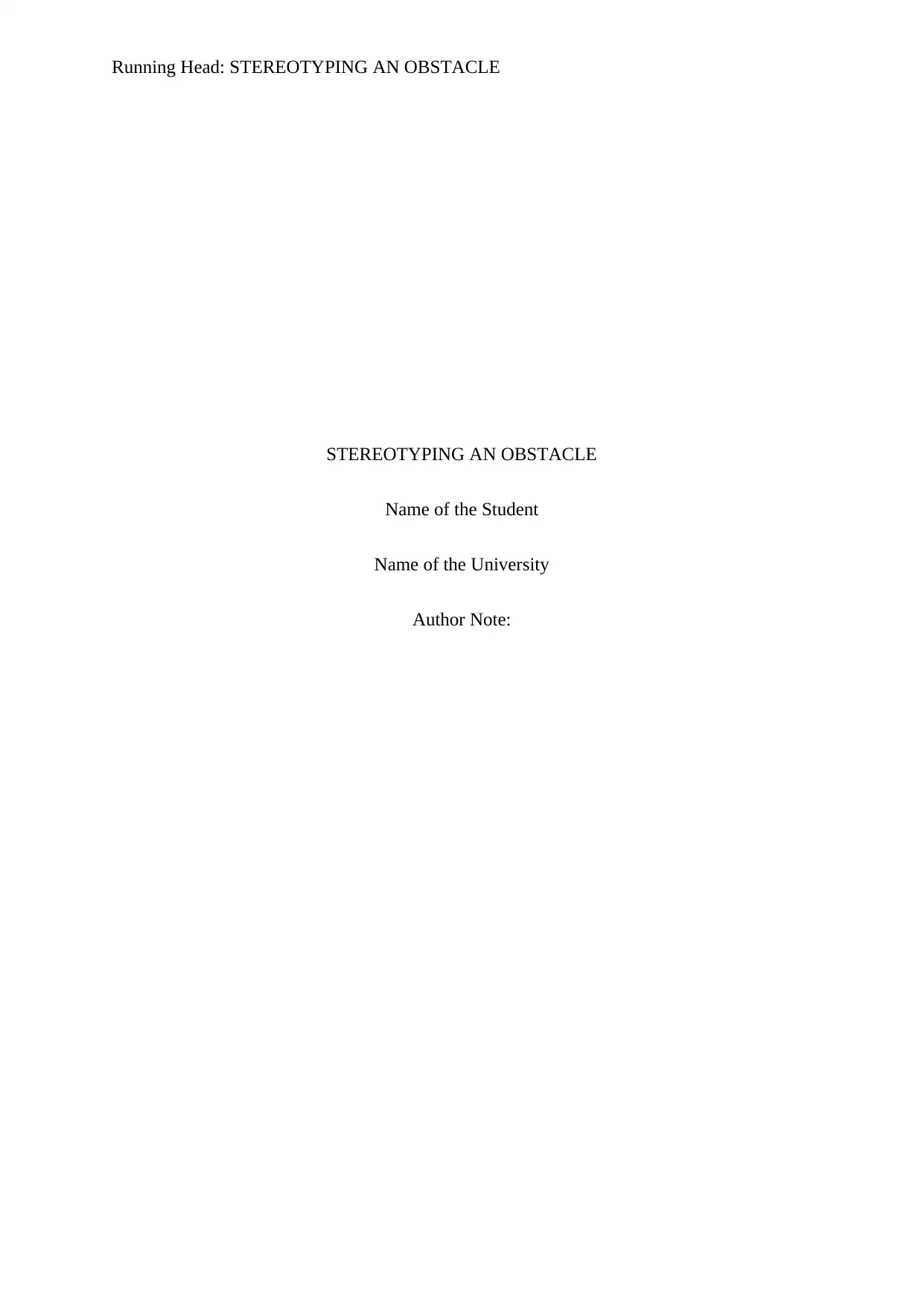
Running Head: STEREOTYPING AN OBSTACLE
STEREOTYPING AN OBSTACLE
Name of the Student
Name of the University
Author Note:
STEREOTYPING AN OBSTACLE
Name of the Student
Name of the University
Author Note:
Paraphrase This Document
Need a fresh take? Get an instant paraphrase of this document with our AI Paraphraser
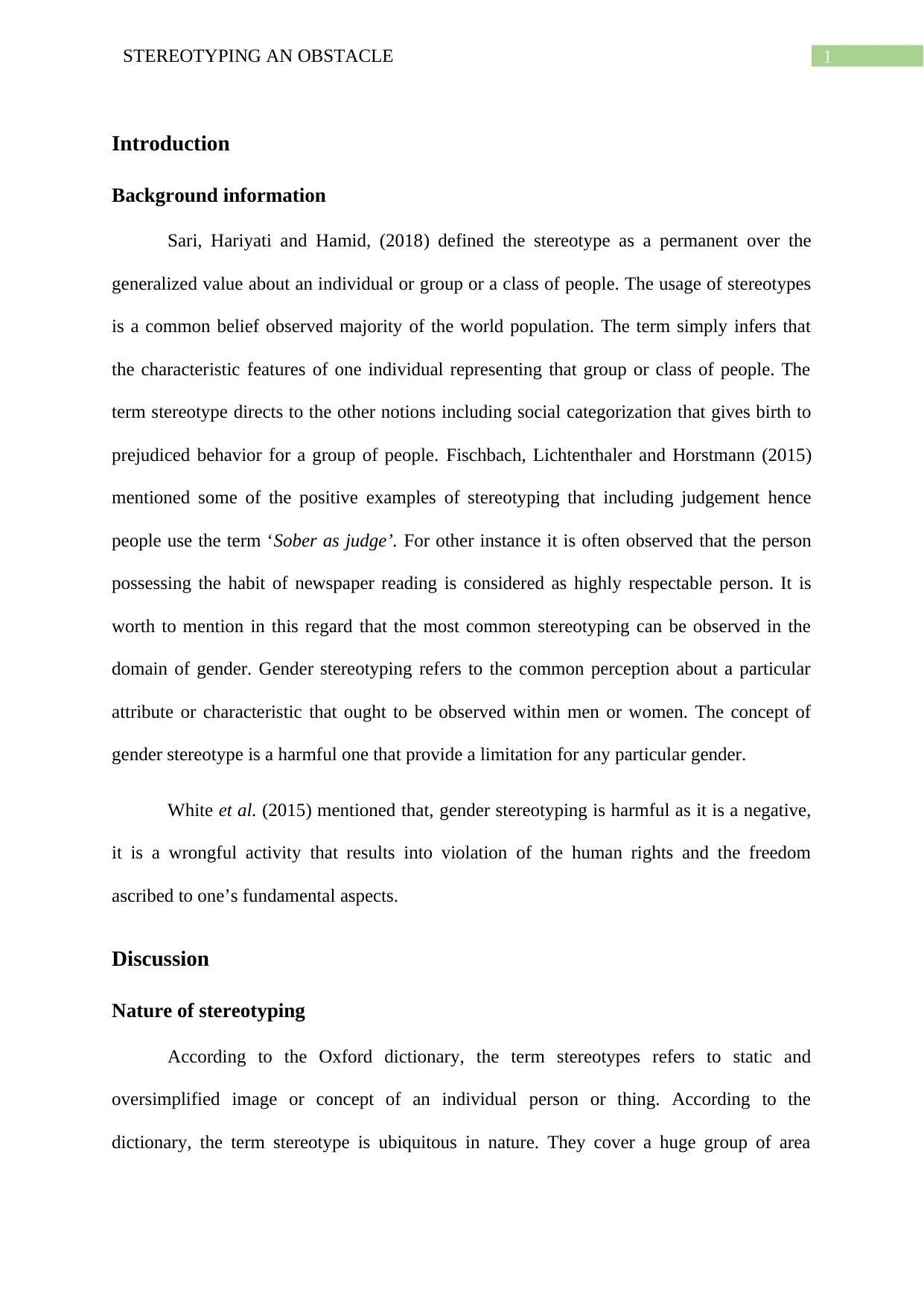
1STEREOTYPING AN OBSTACLE
Introduction
Background information
Sari, Hariyati and Hamid, (2018) defined the stereotype as a permanent over the
generalized value about an individual or group or a class of people. The usage of stereotypes
is a common belief observed majority of the world population. The term simply infers that
the characteristic features of one individual representing that group or class of people. The
term stereotype directs to the other notions including social categorization that gives birth to
prejudiced behavior for a group of people. Fischbach, Lichtenthaler and Horstmann (2015)
mentioned some of the positive examples of stereotyping that including judgement hence
people use the term ‘Sober as judge’. For other instance it is often observed that the person
possessing the habit of newspaper reading is considered as highly respectable person. It is
worth to mention in this regard that the most common stereotyping can be observed in the
domain of gender. Gender stereotyping refers to the common perception about a particular
attribute or characteristic that ought to be observed within men or women. The concept of
gender stereotype is a harmful one that provide a limitation for any particular gender.
White et al. (2015) mentioned that, gender stereotyping is harmful as it is a negative,
it is a wrongful activity that results into violation of the human rights and the freedom
ascribed to one’s fundamental aspects.
Discussion
Nature of stereotyping
According to the Oxford dictionary, the term stereotypes refers to static and
oversimplified image or concept of an individual person or thing. According to the
dictionary, the term stereotype is ubiquitous in nature. They cover a huge group of area
Introduction
Background information
Sari, Hariyati and Hamid, (2018) defined the stereotype as a permanent over the
generalized value about an individual or group or a class of people. The usage of stereotypes
is a common belief observed majority of the world population. The term simply infers that
the characteristic features of one individual representing that group or class of people. The
term stereotype directs to the other notions including social categorization that gives birth to
prejudiced behavior for a group of people. Fischbach, Lichtenthaler and Horstmann (2015)
mentioned some of the positive examples of stereotyping that including judgement hence
people use the term ‘Sober as judge’. For other instance it is often observed that the person
possessing the habit of newspaper reading is considered as highly respectable person. It is
worth to mention in this regard that the most common stereotyping can be observed in the
domain of gender. Gender stereotyping refers to the common perception about a particular
attribute or characteristic that ought to be observed within men or women. The concept of
gender stereotype is a harmful one that provide a limitation for any particular gender.
White et al. (2015) mentioned that, gender stereotyping is harmful as it is a negative,
it is a wrongful activity that results into violation of the human rights and the freedom
ascribed to one’s fundamental aspects.
Discussion
Nature of stereotyping
According to the Oxford dictionary, the term stereotypes refers to static and
oversimplified image or concept of an individual person or thing. According to the
dictionary, the term stereotype is ubiquitous in nature. They cover a huge group of area
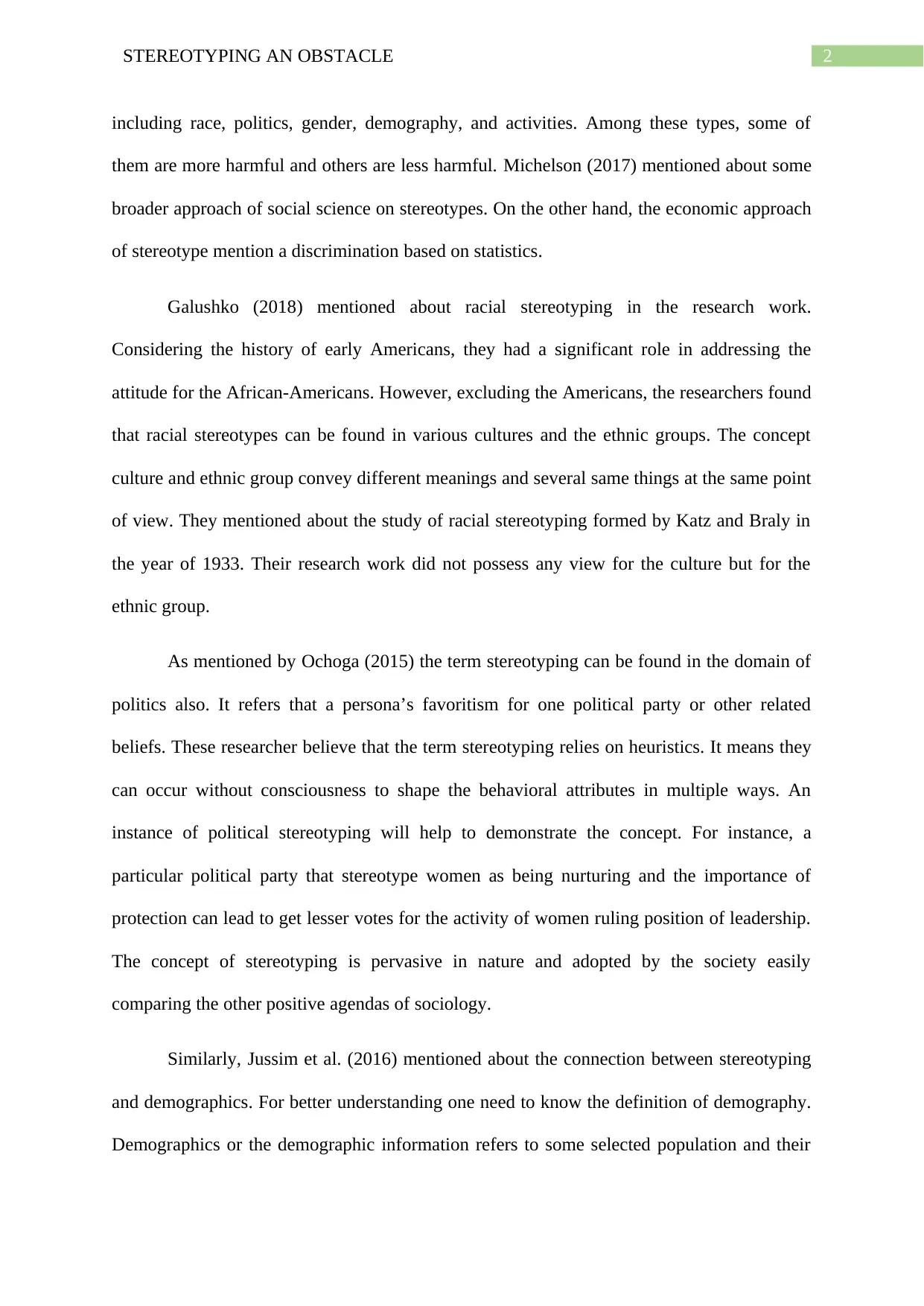
2STEREOTYPING AN OBSTACLE
including race, politics, gender, demography, and activities. Among these types, some of
them are more harmful and others are less harmful. Michelson (2017) mentioned about some
broader approach of social science on stereotypes. On the other hand, the economic approach
of stereotype mention a discrimination based on statistics.
Galushko (2018) mentioned about racial stereotyping in the research work.
Considering the history of early Americans, they had a significant role in addressing the
attitude for the African-Americans. However, excluding the Americans, the researchers found
that racial stereotypes can be found in various cultures and the ethnic groups. The concept
culture and ethnic group convey different meanings and several same things at the same point
of view. They mentioned about the study of racial stereotyping formed by Katz and Braly in
the year of 1933. Their research work did not possess any view for the culture but for the
ethnic group.
As mentioned by Ochoga (2015) the term stereotyping can be found in the domain of
politics also. It refers that a persona’s favoritism for one political party or other related
beliefs. These researcher believe that the term stereotyping relies on heuristics. It means they
can occur without consciousness to shape the behavioral attributes in multiple ways. An
instance of political stereotyping will help to demonstrate the concept. For instance, a
particular political party that stereotype women as being nurturing and the importance of
protection can lead to get lesser votes for the activity of women ruling position of leadership.
The concept of stereotyping is pervasive in nature and adopted by the society easily
comparing the other positive agendas of sociology.
Similarly, Jussim et al. (2016) mentioned about the connection between stereotyping
and demographics. For better understanding one need to know the definition of demography.
Demographics or the demographic information refers to some selected population and their
including race, politics, gender, demography, and activities. Among these types, some of
them are more harmful and others are less harmful. Michelson (2017) mentioned about some
broader approach of social science on stereotypes. On the other hand, the economic approach
of stereotype mention a discrimination based on statistics.
Galushko (2018) mentioned about racial stereotyping in the research work.
Considering the history of early Americans, they had a significant role in addressing the
attitude for the African-Americans. However, excluding the Americans, the researchers found
that racial stereotypes can be found in various cultures and the ethnic groups. The concept
culture and ethnic group convey different meanings and several same things at the same point
of view. They mentioned about the study of racial stereotyping formed by Katz and Braly in
the year of 1933. Their research work did not possess any view for the culture but for the
ethnic group.
As mentioned by Ochoga (2015) the term stereotyping can be found in the domain of
politics also. It refers that a persona’s favoritism for one political party or other related
beliefs. These researcher believe that the term stereotyping relies on heuristics. It means they
can occur without consciousness to shape the behavioral attributes in multiple ways. An
instance of political stereotyping will help to demonstrate the concept. For instance, a
particular political party that stereotype women as being nurturing and the importance of
protection can lead to get lesser votes for the activity of women ruling position of leadership.
The concept of stereotyping is pervasive in nature and adopted by the society easily
comparing the other positive agendas of sociology.
Similarly, Jussim et al. (2016) mentioned about the connection between stereotyping
and demographics. For better understanding one need to know the definition of demography.
Demographics or the demographic information refers to some selected population and their
⊘ This is a preview!⊘
Do you want full access?
Subscribe today to unlock all pages.

Trusted by 1+ million students worldwide
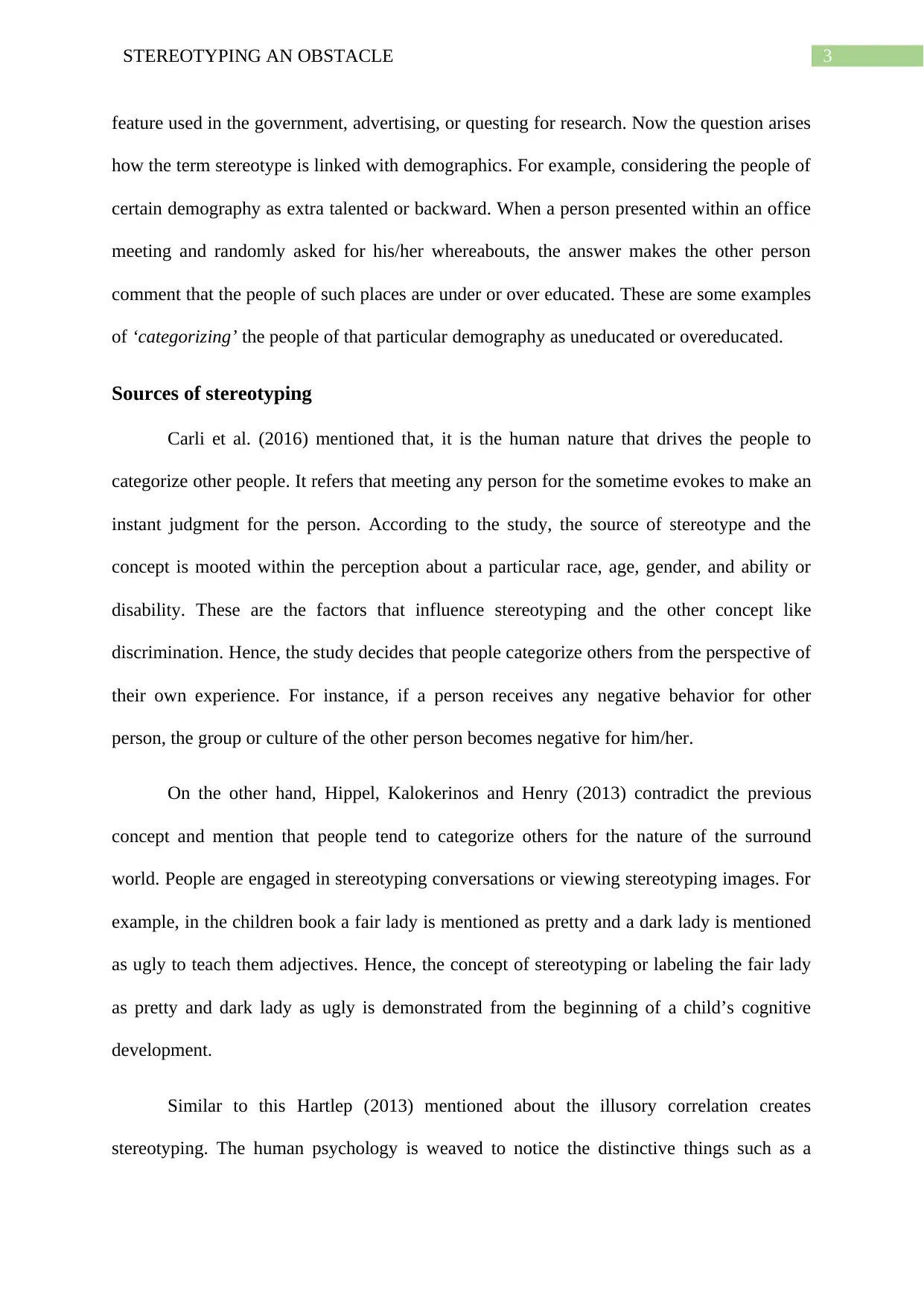
3STEREOTYPING AN OBSTACLE
feature used in the government, advertising, or questing for research. Now the question arises
how the term stereotype is linked with demographics. For example, considering the people of
certain demography as extra talented or backward. When a person presented within an office
meeting and randomly asked for his/her whereabouts, the answer makes the other person
comment that the people of such places are under or over educated. These are some examples
of ‘categorizing’ the people of that particular demography as uneducated or overeducated.
Sources of stereotyping
Carli et al. (2016) mentioned that, it is the human nature that drives the people to
categorize other people. It refers that meeting any person for the sometime evokes to make an
instant judgment for the person. According to the study, the source of stereotype and the
concept is mooted within the perception about a particular race, age, gender, and ability or
disability. These are the factors that influence stereotyping and the other concept like
discrimination. Hence, the study decides that people categorize others from the perspective of
their own experience. For instance, if a person receives any negative behavior for other
person, the group or culture of the other person becomes negative for him/her.
On the other hand, Hippel, Kalokerinos and Henry (2013) contradict the previous
concept and mention that people tend to categorize others for the nature of the surround
world. People are engaged in stereotyping conversations or viewing stereotyping images. For
example, in the children book a fair lady is mentioned as pretty and a dark lady is mentioned
as ugly to teach them adjectives. Hence, the concept of stereotyping or labeling the fair lady
as pretty and dark lady as ugly is demonstrated from the beginning of a child’s cognitive
development.
Similar to this Hartlep (2013) mentioned about the illusory correlation creates
stereotyping. The human psychology is weaved to notice the distinctive things such as a
feature used in the government, advertising, or questing for research. Now the question arises
how the term stereotype is linked with demographics. For example, considering the people of
certain demography as extra talented or backward. When a person presented within an office
meeting and randomly asked for his/her whereabouts, the answer makes the other person
comment that the people of such places are under or over educated. These are some examples
of ‘categorizing’ the people of that particular demography as uneducated or overeducated.
Sources of stereotyping
Carli et al. (2016) mentioned that, it is the human nature that drives the people to
categorize other people. It refers that meeting any person for the sometime evokes to make an
instant judgment for the person. According to the study, the source of stereotype and the
concept is mooted within the perception about a particular race, age, gender, and ability or
disability. These are the factors that influence stereotyping and the other concept like
discrimination. Hence, the study decides that people categorize others from the perspective of
their own experience. For instance, if a person receives any negative behavior for other
person, the group or culture of the other person becomes negative for him/her.
On the other hand, Hippel, Kalokerinos and Henry (2013) contradict the previous
concept and mention that people tend to categorize others for the nature of the surround
world. People are engaged in stereotyping conversations or viewing stereotyping images. For
example, in the children book a fair lady is mentioned as pretty and a dark lady is mentioned
as ugly to teach them adjectives. Hence, the concept of stereotyping or labeling the fair lady
as pretty and dark lady as ugly is demonstrated from the beginning of a child’s cognitive
development.
Similar to this Hartlep (2013) mentioned about the illusory correlation creates
stereotyping. The human psychology is weaved to notice the distinctive things such as a
Paraphrase This Document
Need a fresh take? Get an instant paraphrase of this document with our AI Paraphraser
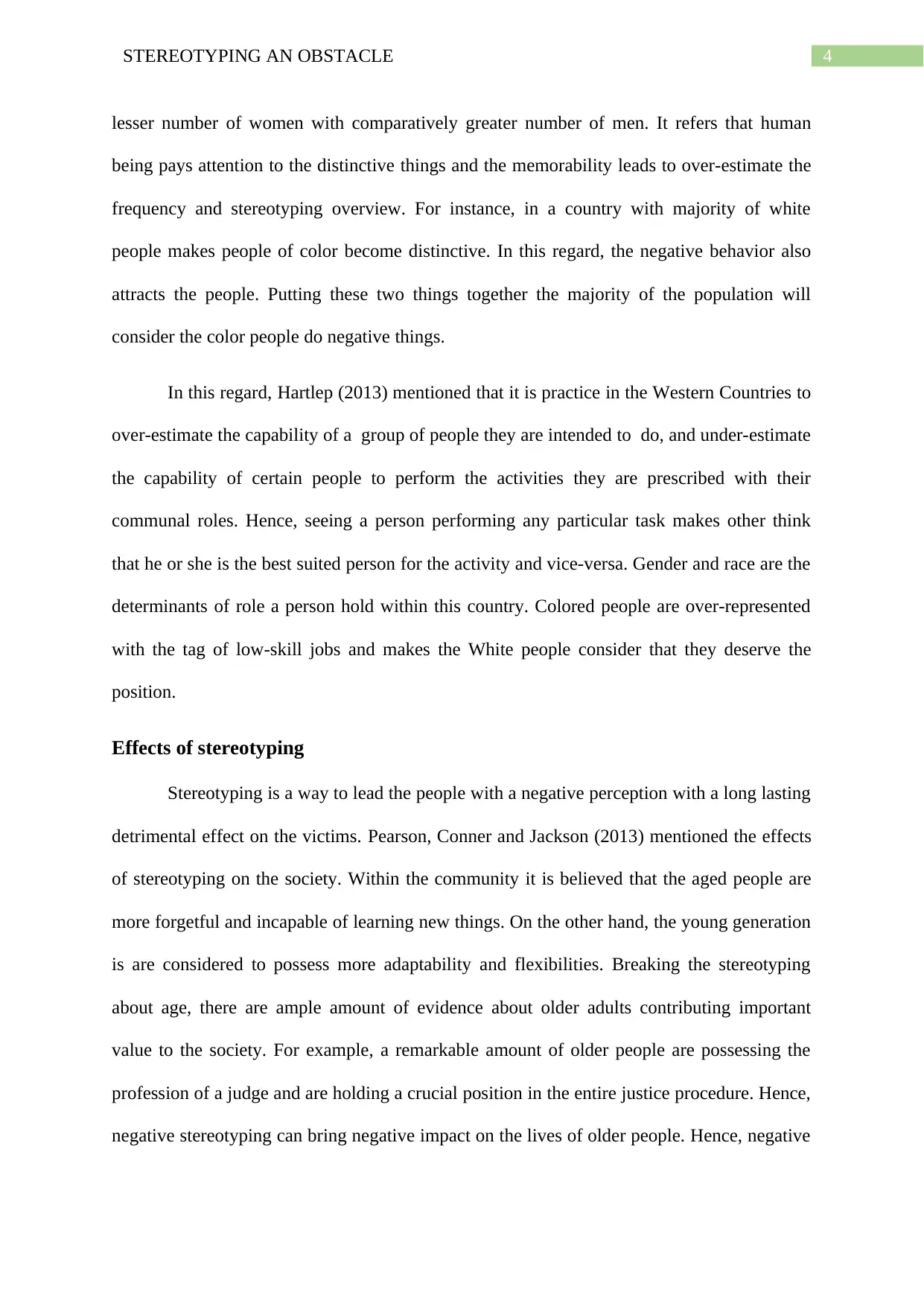
4STEREOTYPING AN OBSTACLE
lesser number of women with comparatively greater number of men. It refers that human
being pays attention to the distinctive things and the memorability leads to over-estimate the
frequency and stereotyping overview. For instance, in a country with majority of white
people makes people of color become distinctive. In this regard, the negative behavior also
attracts the people. Putting these two things together the majority of the population will
consider the color people do negative things.
In this regard, Hartlep (2013) mentioned that it is practice in the Western Countries to
over-estimate the capability of a group of people they are intended to do, and under-estimate
the capability of certain people to perform the activities they are prescribed with their
communal roles. Hence, seeing a person performing any particular task makes other think
that he or she is the best suited person for the activity and vice-versa. Gender and race are the
determinants of role a person hold within this country. Colored people are over-represented
with the tag of low-skill jobs and makes the White people consider that they deserve the
position.
Effects of stereotyping
Stereotyping is a way to lead the people with a negative perception with a long lasting
detrimental effect on the victims. Pearson, Conner and Jackson (2013) mentioned the effects
of stereotyping on the society. Within the community it is believed that the aged people are
more forgetful and incapable of learning new things. On the other hand, the young generation
is are considered to possess more adaptability and flexibilities. Breaking the stereotyping
about age, there are ample amount of evidence about older adults contributing important
value to the society. For example, a remarkable amount of older people are possessing the
profession of a judge and are holding a crucial position in the entire justice procedure. Hence,
negative stereotyping can bring negative impact on the lives of older people. Hence, negative
lesser number of women with comparatively greater number of men. It refers that human
being pays attention to the distinctive things and the memorability leads to over-estimate the
frequency and stereotyping overview. For instance, in a country with majority of white
people makes people of color become distinctive. In this regard, the negative behavior also
attracts the people. Putting these two things together the majority of the population will
consider the color people do negative things.
In this regard, Hartlep (2013) mentioned that it is practice in the Western Countries to
over-estimate the capability of a group of people they are intended to do, and under-estimate
the capability of certain people to perform the activities they are prescribed with their
communal roles. Hence, seeing a person performing any particular task makes other think
that he or she is the best suited person for the activity and vice-versa. Gender and race are the
determinants of role a person hold within this country. Colored people are over-represented
with the tag of low-skill jobs and makes the White people consider that they deserve the
position.
Effects of stereotyping
Stereotyping is a way to lead the people with a negative perception with a long lasting
detrimental effect on the victims. Pearson, Conner and Jackson (2013) mentioned the effects
of stereotyping on the society. Within the community it is believed that the aged people are
more forgetful and incapable of learning new things. On the other hand, the young generation
is are considered to possess more adaptability and flexibilities. Breaking the stereotyping
about age, there are ample amount of evidence about older adults contributing important
value to the society. For example, a remarkable amount of older people are possessing the
profession of a judge and are holding a crucial position in the entire justice procedure. Hence,
negative stereotyping can bring negative impact on the lives of older people. Hence, negative
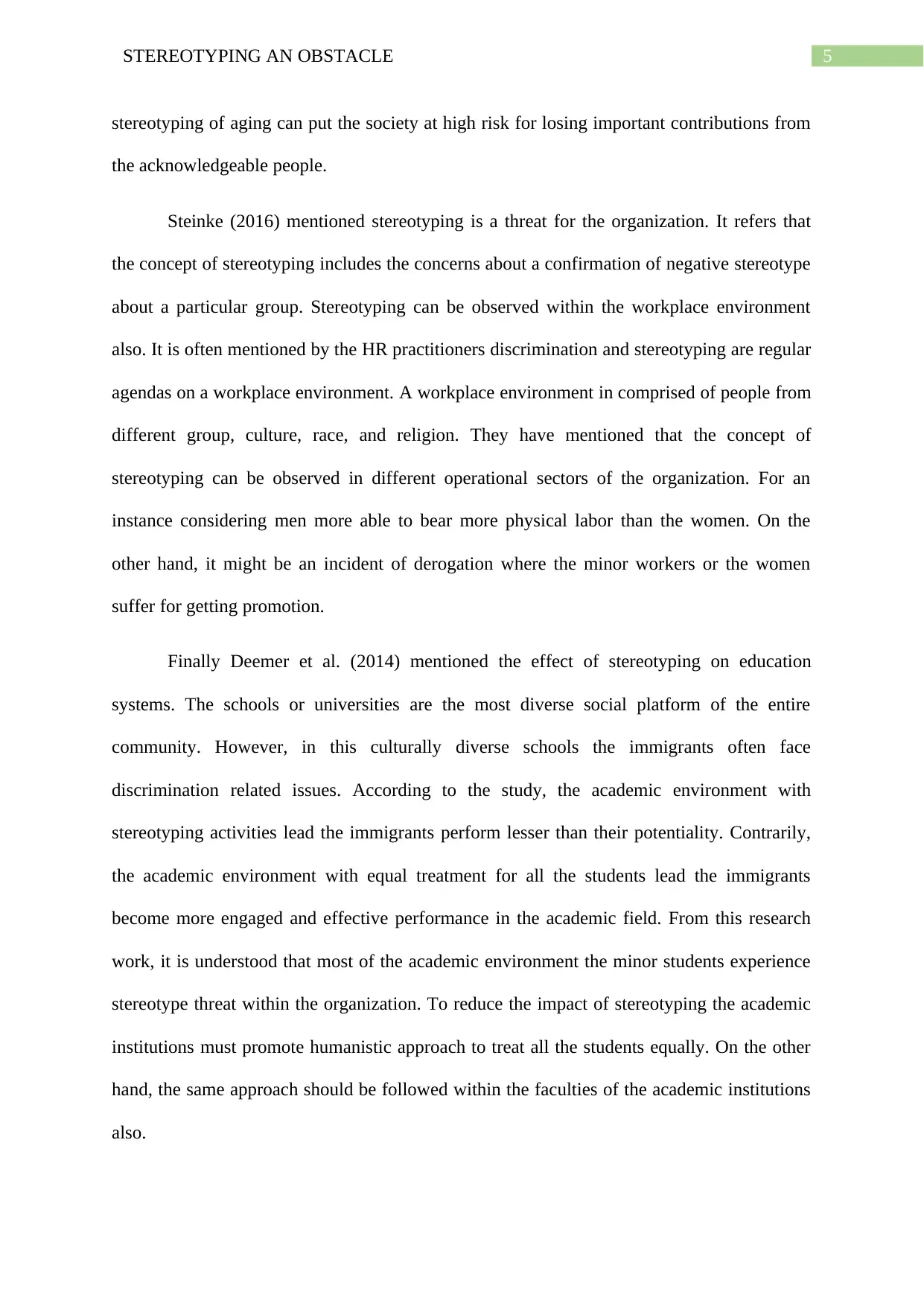
5STEREOTYPING AN OBSTACLE
stereotyping of aging can put the society at high risk for losing important contributions from
the acknowledgeable people.
Steinke (2016) mentioned stereotyping is a threat for the organization. It refers that
the concept of stereotyping includes the concerns about a confirmation of negative stereotype
about a particular group. Stereotyping can be observed within the workplace environment
also. It is often mentioned by the HR practitioners discrimination and stereotyping are regular
agendas on a workplace environment. A workplace environment in comprised of people from
different group, culture, race, and religion. They have mentioned that the concept of
stereotyping can be observed in different operational sectors of the organization. For an
instance considering men more able to bear more physical labor than the women. On the
other hand, it might be an incident of derogation where the minor workers or the women
suffer for getting promotion.
Finally Deemer et al. (2014) mentioned the effect of stereotyping on education
systems. The schools or universities are the most diverse social platform of the entire
community. However, in this culturally diverse schools the immigrants often face
discrimination related issues. According to the study, the academic environment with
stereotyping activities lead the immigrants perform lesser than their potentiality. Contrarily,
the academic environment with equal treatment for all the students lead the immigrants
become more engaged and effective performance in the academic field. From this research
work, it is understood that most of the academic environment the minor students experience
stereotype threat within the organization. To reduce the impact of stereotyping the academic
institutions must promote humanistic approach to treat all the students equally. On the other
hand, the same approach should be followed within the faculties of the academic institutions
also.
stereotyping of aging can put the society at high risk for losing important contributions from
the acknowledgeable people.
Steinke (2016) mentioned stereotyping is a threat for the organization. It refers that
the concept of stereotyping includes the concerns about a confirmation of negative stereotype
about a particular group. Stereotyping can be observed within the workplace environment
also. It is often mentioned by the HR practitioners discrimination and stereotyping are regular
agendas on a workplace environment. A workplace environment in comprised of people from
different group, culture, race, and religion. They have mentioned that the concept of
stereotyping can be observed in different operational sectors of the organization. For an
instance considering men more able to bear more physical labor than the women. On the
other hand, it might be an incident of derogation where the minor workers or the women
suffer for getting promotion.
Finally Deemer et al. (2014) mentioned the effect of stereotyping on education
systems. The schools or universities are the most diverse social platform of the entire
community. However, in this culturally diverse schools the immigrants often face
discrimination related issues. According to the study, the academic environment with
stereotyping activities lead the immigrants perform lesser than their potentiality. Contrarily,
the academic environment with equal treatment for all the students lead the immigrants
become more engaged and effective performance in the academic field. From this research
work, it is understood that most of the academic environment the minor students experience
stereotype threat within the organization. To reduce the impact of stereotyping the academic
institutions must promote humanistic approach to treat all the students equally. On the other
hand, the same approach should be followed within the faculties of the academic institutions
also.
⊘ This is a preview!⊘
Do you want full access?
Subscribe today to unlock all pages.

Trusted by 1+ million students worldwide
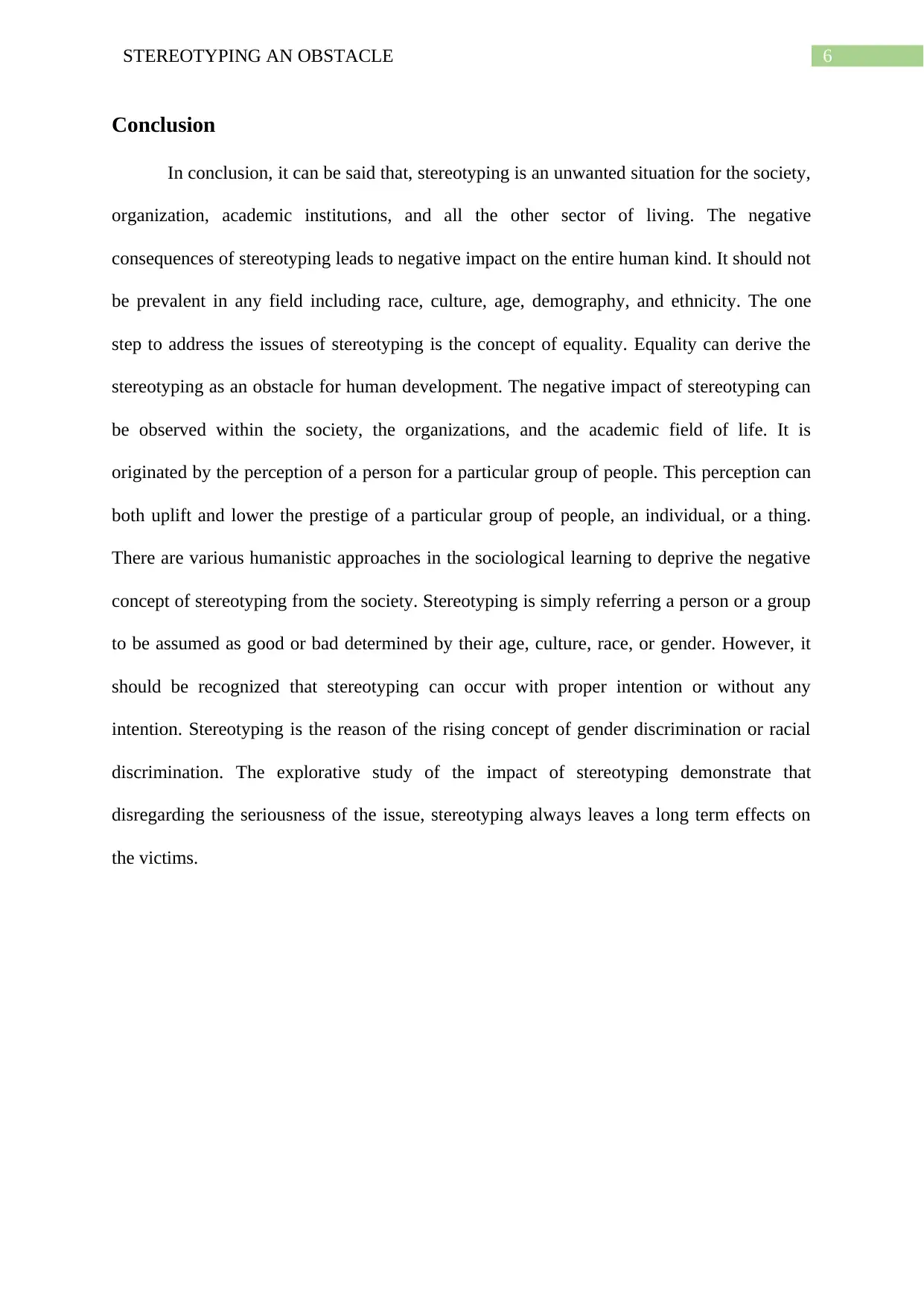
6STEREOTYPING AN OBSTACLE
Conclusion
In conclusion, it can be said that, stereotyping is an unwanted situation for the society,
organization, academic institutions, and all the other sector of living. The negative
consequences of stereotyping leads to negative impact on the entire human kind. It should not
be prevalent in any field including race, culture, age, demography, and ethnicity. The one
step to address the issues of stereotyping is the concept of equality. Equality can derive the
stereotyping as an obstacle for human development. The negative impact of stereotyping can
be observed within the society, the organizations, and the academic field of life. It is
originated by the perception of a person for a particular group of people. This perception can
both uplift and lower the prestige of a particular group of people, an individual, or a thing.
There are various humanistic approaches in the sociological learning to deprive the negative
concept of stereotyping from the society. Stereotyping is simply referring a person or a group
to be assumed as good or bad determined by their age, culture, race, or gender. However, it
should be recognized that stereotyping can occur with proper intention or without any
intention. Stereotyping is the reason of the rising concept of gender discrimination or racial
discrimination. The explorative study of the impact of stereotyping demonstrate that
disregarding the seriousness of the issue, stereotyping always leaves a long term effects on
the victims.
Conclusion
In conclusion, it can be said that, stereotyping is an unwanted situation for the society,
organization, academic institutions, and all the other sector of living. The negative
consequences of stereotyping leads to negative impact on the entire human kind. It should not
be prevalent in any field including race, culture, age, demography, and ethnicity. The one
step to address the issues of stereotyping is the concept of equality. Equality can derive the
stereotyping as an obstacle for human development. The negative impact of stereotyping can
be observed within the society, the organizations, and the academic field of life. It is
originated by the perception of a person for a particular group of people. This perception can
both uplift and lower the prestige of a particular group of people, an individual, or a thing.
There are various humanistic approaches in the sociological learning to deprive the negative
concept of stereotyping from the society. Stereotyping is simply referring a person or a group
to be assumed as good or bad determined by their age, culture, race, or gender. However, it
should be recognized that stereotyping can occur with proper intention or without any
intention. Stereotyping is the reason of the rising concept of gender discrimination or racial
discrimination. The explorative study of the impact of stereotyping demonstrate that
disregarding the seriousness of the issue, stereotyping always leaves a long term effects on
the victims.
Paraphrase This Document
Need a fresh take? Get an instant paraphrase of this document with our AI Paraphraser
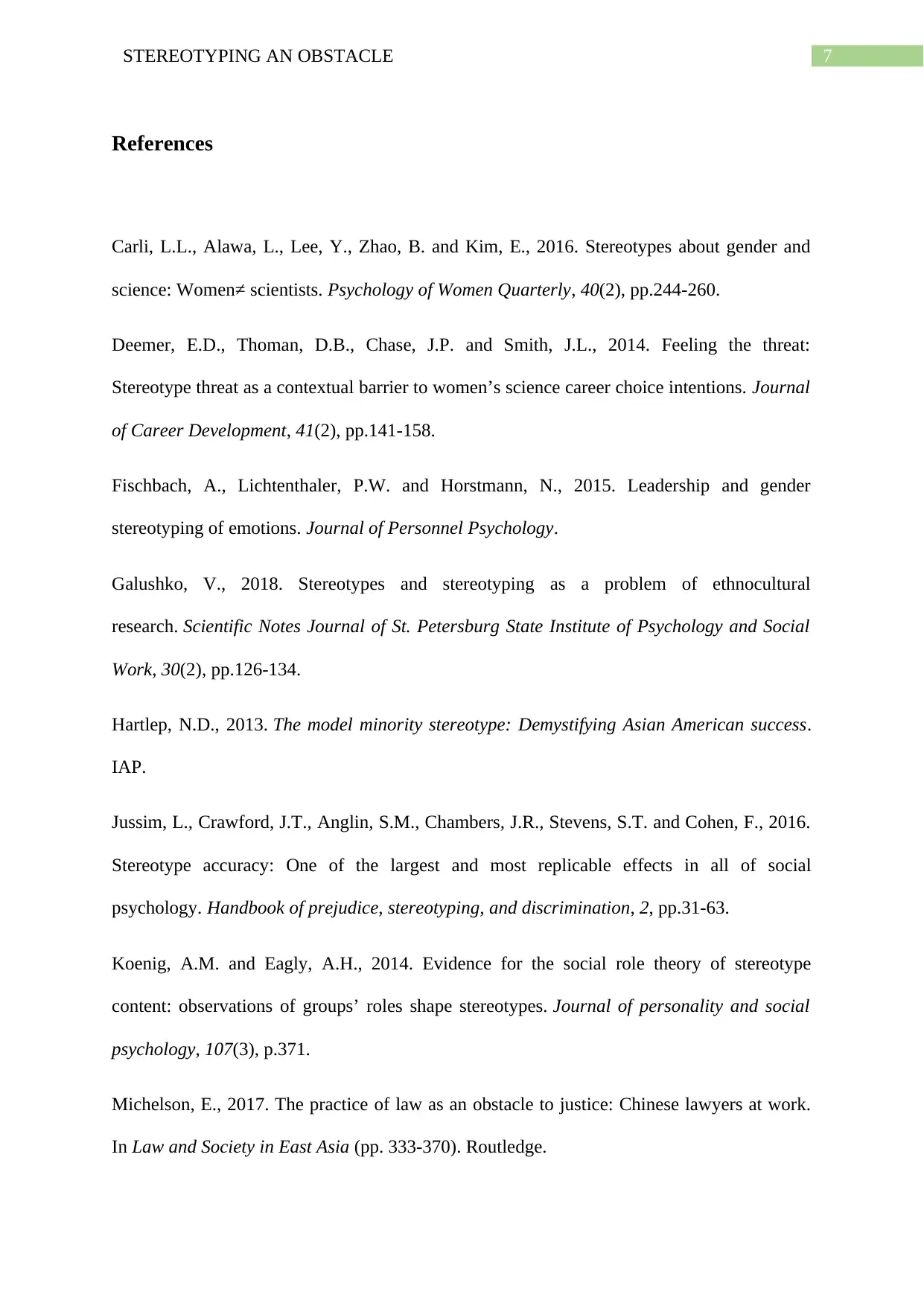
7STEREOTYPING AN OBSTACLE
References
Carli, L.L., Alawa, L., Lee, Y., Zhao, B. and Kim, E., 2016. Stereotypes about gender and
science: Women≠ scientists. Psychology of Women Quarterly, 40(2), pp.244-260.
Deemer, E.D., Thoman, D.B., Chase, J.P. and Smith, J.L., 2014. Feeling the threat:
Stereotype threat as a contextual barrier to women’s science career choice intentions. Journal
of Career Development, 41(2), pp.141-158.
Fischbach, A., Lichtenthaler, P.W. and Horstmann, N., 2015. Leadership and gender
stereotyping of emotions. Journal of Personnel Psychology.
Galushko, V., 2018. Stereotypes and stereotyping as a problem of ethnocultural
research. Scientific Notes Journal of St. Petersburg State Institute of Psychology and Social
Work, 30(2), pp.126-134.
Hartlep, N.D., 2013. The model minority stereotype: Demystifying Asian American success.
IAP.
Jussim, L., Crawford, J.T., Anglin, S.M., Chambers, J.R., Stevens, S.T. and Cohen, F., 2016.
Stereotype accuracy: One of the largest and most replicable effects in all of social
psychology. Handbook of prejudice, stereotyping, and discrimination, 2, pp.31-63.
Koenig, A.M. and Eagly, A.H., 2014. Evidence for the social role theory of stereotype
content: observations of groups’ roles shape stereotypes. Journal of personality and social
psychology, 107(3), p.371.
Michelson, E., 2017. The practice of law as an obstacle to justice: Chinese lawyers at work.
In Law and Society in East Asia (pp. 333-370). Routledge.
References
Carli, L.L., Alawa, L., Lee, Y., Zhao, B. and Kim, E., 2016. Stereotypes about gender and
science: Women≠ scientists. Psychology of Women Quarterly, 40(2), pp.244-260.
Deemer, E.D., Thoman, D.B., Chase, J.P. and Smith, J.L., 2014. Feeling the threat:
Stereotype threat as a contextual barrier to women’s science career choice intentions. Journal
of Career Development, 41(2), pp.141-158.
Fischbach, A., Lichtenthaler, P.W. and Horstmann, N., 2015. Leadership and gender
stereotyping of emotions. Journal of Personnel Psychology.
Galushko, V., 2018. Stereotypes and stereotyping as a problem of ethnocultural
research. Scientific Notes Journal of St. Petersburg State Institute of Psychology and Social
Work, 30(2), pp.126-134.
Hartlep, N.D., 2013. The model minority stereotype: Demystifying Asian American success.
IAP.
Jussim, L., Crawford, J.T., Anglin, S.M., Chambers, J.R., Stevens, S.T. and Cohen, F., 2016.
Stereotype accuracy: One of the largest and most replicable effects in all of social
psychology. Handbook of prejudice, stereotyping, and discrimination, 2, pp.31-63.
Koenig, A.M. and Eagly, A.H., 2014. Evidence for the social role theory of stereotype
content: observations of groups’ roles shape stereotypes. Journal of personality and social
psychology, 107(3), p.371.
Michelson, E., 2017. The practice of law as an obstacle to justice: Chinese lawyers at work.
In Law and Society in East Asia (pp. 333-370). Routledge.
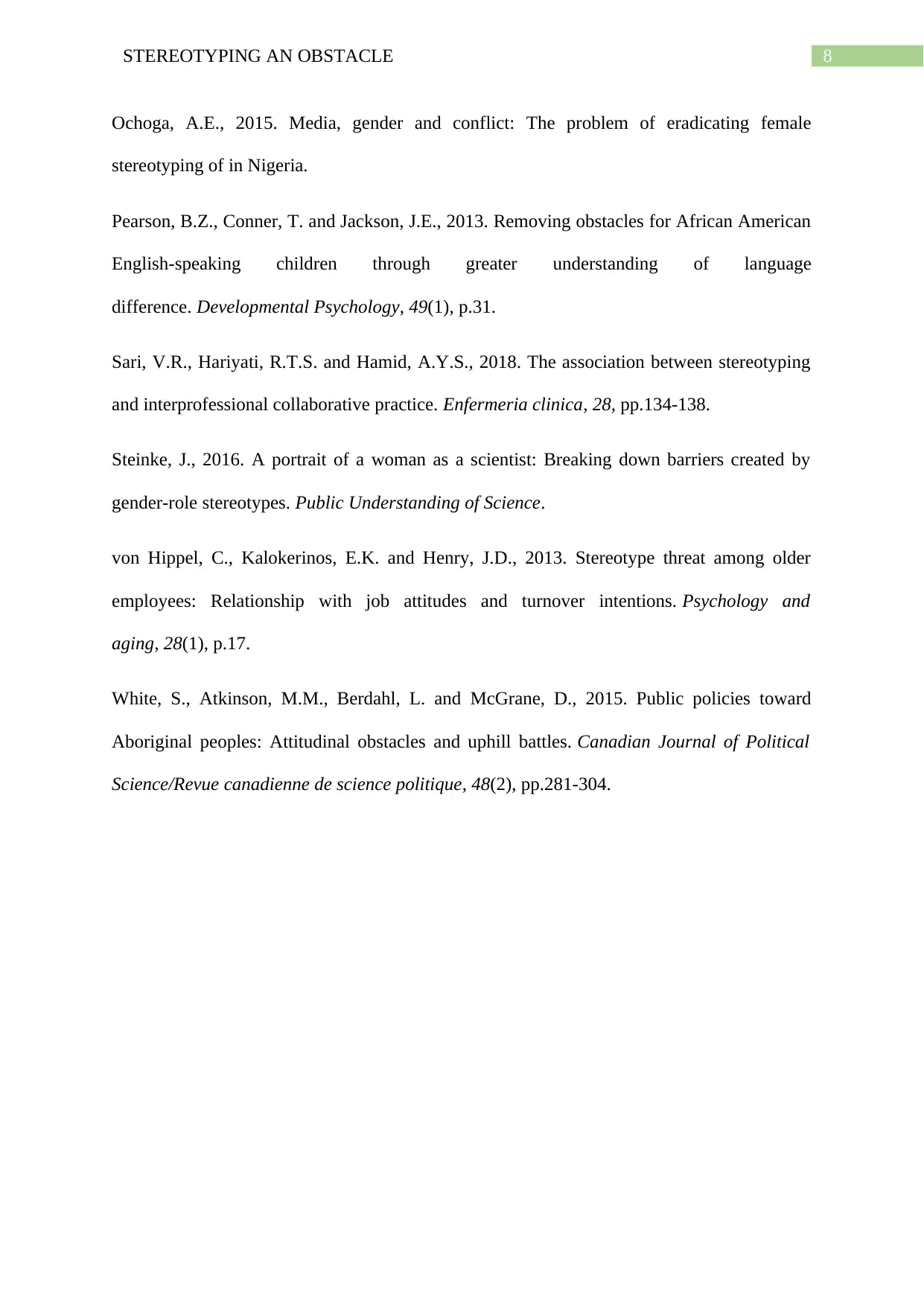
8STEREOTYPING AN OBSTACLE
Ochoga, A.E., 2015. Media, gender and conflict: The problem of eradicating female
stereotyping of in Nigeria.
Pearson, B.Z., Conner, T. and Jackson, J.E., 2013. Removing obstacles for African American
English-speaking children through greater understanding of language
difference. Developmental Psychology, 49(1), p.31.
Sari, V.R., Hariyati, R.T.S. and Hamid, A.Y.S., 2018. The association between stereotyping
and interprofessional collaborative practice. Enfermeria clinica, 28, pp.134-138.
Steinke, J., 2016. A portrait of a woman as a scientist: Breaking down barriers created by
gender-role stereotypes. Public Understanding of Science.
von Hippel, C., Kalokerinos, E.K. and Henry, J.D., 2013. Stereotype threat among older
employees: Relationship with job attitudes and turnover intentions. Psychology and
aging, 28(1), p.17.
White, S., Atkinson, M.M., Berdahl, L. and McGrane, D., 2015. Public policies toward
Aboriginal peoples: Attitudinal obstacles and uphill battles. Canadian Journal of Political
Science/Revue canadienne de science politique, 48(2), pp.281-304.
Ochoga, A.E., 2015. Media, gender and conflict: The problem of eradicating female
stereotyping of in Nigeria.
Pearson, B.Z., Conner, T. and Jackson, J.E., 2013. Removing obstacles for African American
English-speaking children through greater understanding of language
difference. Developmental Psychology, 49(1), p.31.
Sari, V.R., Hariyati, R.T.S. and Hamid, A.Y.S., 2018. The association between stereotyping
and interprofessional collaborative practice. Enfermeria clinica, 28, pp.134-138.
Steinke, J., 2016. A portrait of a woman as a scientist: Breaking down barriers created by
gender-role stereotypes. Public Understanding of Science.
von Hippel, C., Kalokerinos, E.K. and Henry, J.D., 2013. Stereotype threat among older
employees: Relationship with job attitudes and turnover intentions. Psychology and
aging, 28(1), p.17.
White, S., Atkinson, M.M., Berdahl, L. and McGrane, D., 2015. Public policies toward
Aboriginal peoples: Attitudinal obstacles and uphill battles. Canadian Journal of Political
Science/Revue canadienne de science politique, 48(2), pp.281-304.
⊘ This is a preview!⊘
Do you want full access?
Subscribe today to unlock all pages.

Trusted by 1+ million students worldwide
1 out of 9
Related Documents
Your All-in-One AI-Powered Toolkit for Academic Success.
+13062052269
info@desklib.com
Available 24*7 on WhatsApp / Email
![[object Object]](/_next/static/media/star-bottom.7253800d.svg)
Unlock your academic potential
Copyright © 2020–2025 A2Z Services. All Rights Reserved. Developed and managed by ZUCOL.





